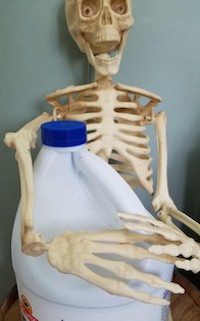Household bleach – it all began around the time of World War 1, when researchers discovered that introducing electrical current into salt water broke down the salt molecules. The end result of the process is sodium hypochlorite.
Bleach, as you know, is a strong and extremely effective disinfectant. Its active ingredient, mentioned above, is sodium hypochlorite NaOCl).
Sodium hypochlorite denatures protein in micro-organisms. Therefore it’s able to kill bacteria, fungus, and viruses. The antimicrobial action of sodium hypochlorite solutions occurs by disrupting the structure and function of protein, as well as oxidative cell destruction. Microbes, by the way, are unable to develop resistance to sodium hypochlorite.
Diluted household bleach—NOT full strength—is recommended for use as a disinfectant.
Bleach Has a Short Lifespan!
Bleach has a relatively short “life cycle” that begins and ends with common table salt (NaCl).
Step One – Electrolysis: an electric current run through salt water producing chlorine and caustic (NaOH).
Step Two – Household bleach is made by bubbling chlorine into a solution of water and caustic.
Step Three – Bleach production for sale and distribution. During production, sodium hypochlorite is diluted with water to create specific concentrations.
Step Four – Bleach is used by consumers to break down soil and kill bacteria and viruses. The result is enhanced cleaning and whitening, and disinfecting.
Step Five -The cycle of life for bleach is complete as approximately 95-98% of it returns to salt after typical household use and/or storage. The remaining 2-5% is makes its way into sewer and septic systems.
Bleach decomposes under heat or light. Overuse of bleach or using a bleach solution that is too concentrated (not properly diluted) could result in the production of toxic substances that pollute the environment and cause a disturbance in ecological balances.
The Recipe
The recipe for the most effective bleach solution as a disinfectant is one part bleach to nine parts water, a 1:10 ratio.
Bleach solutions should be stored in opaque containers and must be made fresh at a minimum of every 24 hours. Bleach rapidly degrades in the presence of light and when mixed with water. This is especially important when disinfecting due to coronavirus concerns.
A 1:32 solution of regular household bleach works for daily, everyday use in the home. Bleach solutions at concentrations less than this may not be effective, offering a false sense of security. Bleach solutions of higher concentrations greater than this can and does cause respiratory tract irritation in both people and animals.
Bleach remains highly effective for around 6 months and is still okay for home use for around 9 months after its manufacture date. Clorox recommends replacing any bottle of bleach that is over a year old.
Bleach solutions require a full 10 minutes of contact time to ensure that surfaces are appropriately disinfected. Rule of thumb – If a bleach solution evaporates prior to the 10-minute timeframe, then the amount of bleach solution used was not enough!
Where and When Is Your Bleach Made?
Since many of you seem to be in need of new things to do during the stay at home isolation period (I know, we can only watch just so many episodes of Family Guy, and cooking and home remodeling shows before we shoot the TV), here’s a bit of quirky information.
According to the Clorox website, the production code on the neck of each bottle provides the date of manufacture, the identity of the manufacturing plant, and the day of the year the the bleach was bottled. Clorox uses the example code A81421321CA3. Starting on the left and moving right, the plant number is “A8.” The next two numbers, “14,” indicate the year of manufacture (2014). The next three numbers, 213 indicate the 213th day of the year. Therefore, we know this particular bottle of bleach was made at plant A8 on August 1st, 2014.
Safety and First Aid
If bleach gets into the eyes, immediately rinse with water for at least 15 minutes and consult a doctor.
Bleach should not be used together or mixed with other household cleaners for a couple of reasons. One, doing so reduces its effectiveness to disinfect. Two, a chemical reaction could occur, such as the highly toxic gas that’s produced when bleach is mixed with acidic detergents such as toilet and other types of cleaners.
Undiluted bleach produces a toxic gas when exposed to sunlight. Always store in a cool, shaded place. And always store bleach out of reach of children.
Remember!
Sodium hypochlorite decomposes with time. To ensure its effectiveness, it is advised to purchase recently produced bleach (check expiration and manufacture dates!) Diluted bleach should be used within 24 hours after preparation/mixing with water. Again, bleach decomposes with time. One way to tell if bleach has decomposed and returned to nothing more than salt and water, is if you no longer smell the familiar “bleach smell” when opening the bottle.
Scented and splash-less bleaches are NOT recommended for use as disinfectants.
Did You Know …
- Bleach does not produce chlorine gas.
- Sodium hypochlorite has no actual odor.
- The “bleach smell” comes from the bleach mingling with organic mater. And, the more soil it contacts the stronger the smell. A strong odor of chlorine in a swimming pool is an indication of an elevated “funk content” in the water.
- Bleach’s odor is caused by the chemical reactions that occur when bleach begins to break down proteins.
- Bleach does not cause Cancer!
- Clostridium difficile (C. diff) is a bacteria found in the intestines that can cause diarrhea and serious illness. Airborne C. diff spores can be recovered in up to 10 inches above a contaminated toilet seat after flushing.
Up to 1 in 4 healthcare workers’ hands are contaminated with C. difficile spores after caring for C. dIff patients. The use of bleach has been used successful in reducing the transmission of Clostridium difficile.
Crime Scenes and the Heroes and Villains of Your Twisted Tales

Decontamination of blood or body fluid spills
When a villain wants to “clean up” after creating a messy spill or accidental leakage of blood or other body fluids, he/she should use 1:10 bleach solution to inactivate pathogens. Then use absorbent materials to soaking up those fluids. A trip to the backyard burn barrel is a must for the incineration of the soiled towels and other material.
Overexposed!
In an early release today, the CDC reports a 20% increase in the number of calls to U.S. poison control centers regarding cleaners and disinfectants


